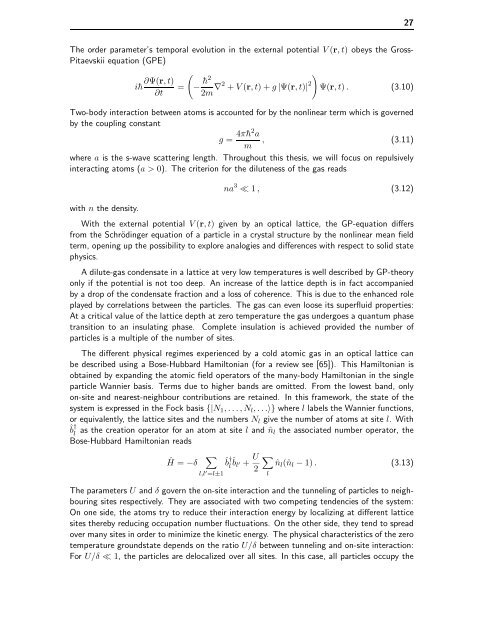Bose-Einstein Condensates in Rotating Traps and Optical ... - BEC
Bose-Einstein Condensates in Rotating Traps and Optical ... - BEC
Bose-Einstein Condensates in Rotating Traps and Optical ... - BEC
You also want an ePaper? Increase the reach of your titles
YUMPU automatically turns print PDFs into web optimized ePapers that Google loves.
The order parameter’s temporal evolution <strong>in</strong> the external potential V (r,t) obeys the Gross-<br />
Pitaevskii equation (GPE)<br />
i¯h ∂Ψ(r,t)<br />
∂t<br />
27<br />
<br />
= − ¯h2<br />
2m ∇2 + V (r,t)+g |Ψ(r,t)| 2<br />
<br />
Ψ(r,t) . (3.10)<br />
Two-body <strong>in</strong>teraction between atoms is accounted for by the nonl<strong>in</strong>ear term which is governed<br />
by the coupl<strong>in</strong>g constant<br />
g = 4π¯h2 a<br />
, (3.11)<br />
m<br />
where a is the s-wave scatter<strong>in</strong>g length. Throughout this thesis, we will focus on repulsively<br />
<strong>in</strong>teract<strong>in</strong>g atoms (a >0). The criterion for the diluteness of the gas reads<br />
na 3 ≪ 1 , (3.12)<br />
with n the density.<br />
With the external potential V (r,t) given by an optical lattice, the GP-equation differs<br />
from the Schröd<strong>in</strong>ger equation of a particle <strong>in</strong> a crystal structure by the nonl<strong>in</strong>ear mean field<br />
term, open<strong>in</strong>g up the possibility to explore analogies <strong>and</strong> differences with respect to solid state<br />
physics.<br />
A dilute-gas condensate <strong>in</strong> a lattice at very low temperatures is well described by GP-theory<br />
only if the potential is not too deep. An <strong>in</strong>crease of the lattice depth is <strong>in</strong> fact accompanied<br />
by a drop of the condensate fraction <strong>and</strong> a loss of coherence. This is due to the enhanced role<br />
played by correlations between the particles. The gas can even loose its superfluid properties:<br />
At a critical value of the lattice depth at zero temperature the gas undergoes a quantum phase<br />
transition to an <strong>in</strong>sulat<strong>in</strong>g phase. Complete <strong>in</strong>sulation is achieved provided the number of<br />
particles is a multiple of the number of sites.<br />
The different physical regimes experienced by a cold atomic gas <strong>in</strong> an optical lattice can<br />
be described us<strong>in</strong>g a <strong>Bose</strong>-Hubbard Hamiltonian (for a review see [65]). This Hamiltonian is<br />
obta<strong>in</strong>ed by exp<strong>and</strong><strong>in</strong>g the atomic field operators of the many-body Hamiltonian <strong>in</strong> the s<strong>in</strong>gle<br />
particle Wannier basis. Terms due to higher b<strong>and</strong>s are omitted. From the lowest b<strong>and</strong>, only<br />
on-site <strong>and</strong> nearest-neighbour contributions are reta<strong>in</strong>ed. In this framework, the state of the<br />
system is expressed <strong>in</strong> the Fock basis {|N1,...,Nl,...〉} where l labels the Wannier functions,<br />
or equivalently, the lattice sites <strong>and</strong> the numbers Nl give the number of atoms at site l. With<br />
ˆ† b l as the creation operator for an atom at site l <strong>and</strong> ˆnl the associated number operator, the<br />
<strong>Bose</strong>-Hubbard Hamiltonian reads<br />
ˆH = −δ <br />
<br />
ˆnl(ˆnl − 1) . (3.13)<br />
l,l ′ =l±1<br />
ˆ† b l ˆ U<br />
bl ′ +<br />
2<br />
The parameters U <strong>and</strong> δ govern the on-site <strong>in</strong>teraction <strong>and</strong> the tunnel<strong>in</strong>g of particles to neighbour<strong>in</strong>g<br />
sites respectively. They are associated with two compet<strong>in</strong>g tendencies of the system:<br />
On one side, the atoms try to reduce their <strong>in</strong>teraction energy by localiz<strong>in</strong>g at different lattice<br />
sites thereby reduc<strong>in</strong>g occupation number fluctuations. On the other side, they tend to spread<br />
over many sites <strong>in</strong> order to m<strong>in</strong>imize the k<strong>in</strong>etic energy. The physical characteristics of the zero<br />
temperature groundstate depends on the ratio U/δ between tunnel<strong>in</strong>g <strong>and</strong> on-site <strong>in</strong>teraction:<br />
For U/δ ≪ 1, the particles are delocalized over all sites. In this case, all particles occupy the<br />
l




